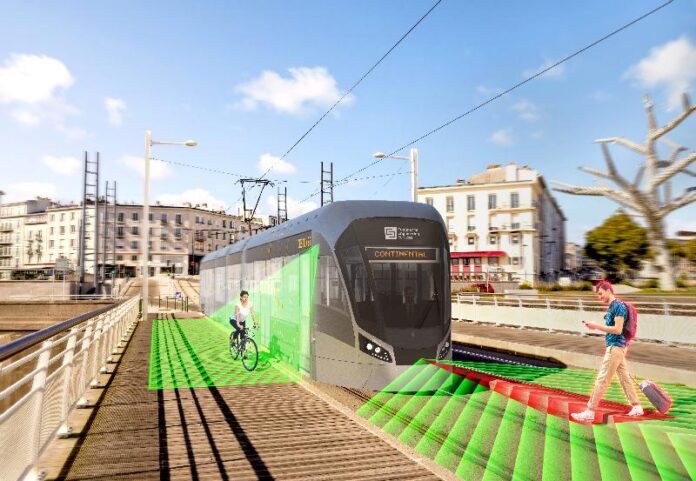Continental has developed a head-up display (HUD) for trams. The display solution from the in-house development and production service provider Continental Engineering Services (CES) is aimed at making intra-urban traffic safer by ensuring that tram drivers can focus their full attention on what is happening on the road. This also enables, for instance, a reduction in the number of emergency braking maneuvers. Trams mostly operate in heavy and frequently challenging inner-city traffic, an environment in which the number of unprotected road users is increasing: More people are cycling or riding e-scooters or compact electric mopeds. Moreover, many road users allow themselves to be distracted by their cell phones. According to information from the transport services, this has resulted in an increasing number of accidents, including those involving trams.
Commissioned by a rail vehicle manufacturer, Continental Engineering Services is currently bringing the innovative display to production maturity. It will initially be used in Europe from the middle of this year. CES is doing important pioneering work here: To date, real head-up displays have been non-existent in rail transportation. Key components of the display, including the powerful light source, come from Continental’s automotive portfolio, and are already installed in various vehicle models from major automotive manufacturers. “With the development of a head-up display for trams, we are taking a major step toward greater safety in urban rail transport,” explains Dr. Christoph Falk-Gierlinger, General Manager of CES. “Information previously displayed on different cockpit instruments can now be placed in the driver’s field of vision via a central head-up display. Their view is not distracted from the traffic. The journey will become safer for tram drivers and passengers.”
The advantages of using head-up displays in rail vehicles are immense. As in the automotive sector, the trend is toward ever larger windshields and consequently lower set dashboards. Here however, the necessary head movements distract from the traffic situation. Moreover, the eyes constantly have to switch focus between near and far vision as the driver’s gaze moves between cockpit and road. This is very tiring for the driver. Projecting vital information – for example, warning signals, speed, distance to the next stop – in the driver’s direct field of vision makes driving more comfortable, resulting in greater safety. This is particularly the case because information is displayed virtually as if it were at some distance in front of the vehicle. That way, the eyes do not have to constantly refocus.
The new Combiner head-up display projects information onto an external transparent screen in the driver’s field of vision. This enables cost-effective use of the technology regardless of the respective manufacturer models – both in newly-developed vehicles and as a retrofit for existing models. Drivers are not only able to see the road and cockpit display simultaneously, the information also appears at what is perceived as the same distance. Furthermore: Thanks to extremely powerful LEDs, the head-up display from Continental, which has already proven itself as a premium solution in the automotive sector, meets the highest standards in terms of light and image quality, even in strong sunshine.
CES has in-depth understanding of and expertise in adapting automotive technologies from large-scale production for new areas of application. In addition to the innovative head-up display, CES’s technology portfolio for rail vehicles also includes other system technology solutions: driver status monitoring, which monitors the driver using a camera, or a front or side-facing collision warning system, for example. All these technologies have already been successfully brought to the road in the passenger car or commercial vehicle sector. For their use in trams, CES engineers intensively studied the operation and control of trams, the technical challenges and the design of tram cockpits. In close collaboration with a major manufacturer of rail vehicles, the first step was to develop a head-up display solution that is innovative and tailor-made for rail transport based on automotive quality standards. Further fields of application are conceivable in future – the technology can also be used in long-distance trains.
Continental develops ground-breaking technologies and services for sustainable and connected mobility of people and their goods. Founded in 1871, the technology company offers safe, efficient, intelligent and affordable solutions for vehicles, machines, traffic, and transportation. Continental generated sales of 37.7 billion euros in 2020 and currently employs more than 192,000 people in 58 countries and markets. On October 8, 2021, the company celebrated its 150th Anniversary.
Continental Engineering Services (CES) was founded in 2006, and as an agile and flexible engineering and production partner develops tailor-made, technologically sophisticated solutions for a wide range of applications, including automotive, railway engineering, aviation, shipping, mining and smart cities. 2,000 employees worldwide contribute their expertise and experience in the key technologies for automated driving, information management & connectivity, electrification and services in the field of multimodal mobility. This makes possible a new level of individual, safe and sustainable mobility.




